what causes air to get into water lines?
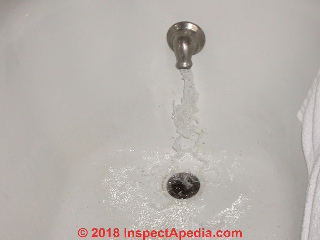 Diagnose & Repair Air Discharge at Faucets
Diagnose & Repair Air Discharge at Faucets
or at Water Supply Pipe / Fixtures
- POST a QUESTION or COMMENT about air discharge at plumbing equipment and/or backlog air in water pressure tanks or in well h2o systems
InspectAPedia tolerates no conflicts of interest. We have no relationship with advertisers, products, or services discussed at this website.
How to diagnose & set up air coming out of faucets:
This commodity describes the causes of air discharging from building water supply pipe or fitting or the sources of excess air in h2o force per unit area tanks, water supply piping, or other plumbing equipment.
If air blasts out of your faucets or fixtures we explain what's going on, why it'southward a problem, and how to diagnose and fix the trouble.
Some air discharge or bubbling issues in building piping are not serious, while others could spell expensive problem. We list the various causes of air discharge at faucets or shower heads and how to correct each ane.
We likewise provide an Commodity INDEX for this topic, or you can effort the page peak or bottom SEARCH BOX as a quick style to detect information you need.
Causes of Air Discharge from Building Fitting
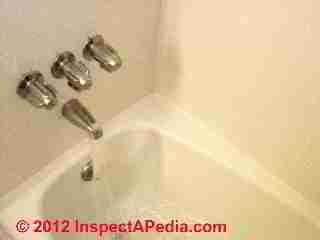 Air blasts or air bubbles coming from plumbing equipment such as faucets, showers, or toilets may be a temporary problem that cures itself or it may be a sign of a deteriorating water well.
Air blasts or air bubbles coming from plumbing equipment such as faucets, showers, or toilets may be a temporary problem that cures itself or it may be a sign of a deteriorating water well.
Here we listing various causes of air in building h2o supply pipe and fixtures to help in diagnosing and repairing this problem. We are going to cover the post-obit:
Excess air in the water force per unit area tank or well piping organisation: causes and cures.
Significance of large bursts of air at faucets & Significance of fine white bubbles in water taken from a faucet.
Signs of loss of well water & Signs of well piping leaks. Signs of water pump failure.
Water pressure tank air volume control problems: How to restore lost air in a building water pressure tank.
What is a snifter valve used on a well water system and how do they work? Hidden and antiquarian air book control valves and features can explain well pump rapid cycling problems & air discharge troubles at faucets & fixtures.
[Click to overstate any image]
Question: Why is air coming out of my faucets, what does it mean, and what tin can I practice to diagnose and fix the trouble?
For a couple months now nosotros've had excessive air in our water lines, similar to after in that location has been a ability outage and the water spurts out of the faucets. I'm trying to figure out a solution to our water problems.
We continuously have air in our h2o supply at all faucets, toilets, and showers; the air is intermittent, and spurts out while water is running, anywhere from immediately later faucet is turned on to a couple minutes later (in shower, for example).
Flushing the toilet results in the pipes or toilet valve banging. we take a well that'south 204' deep, and the submersible pump was replaced in July 2005 (five years ago).
Our h2o pressure level tank is working fine, turning on/shutting off at 30/lx.
After shutting off, with no water running, the pressure holds steady at 60. When the pressure tank is drawing water from the well, you can hear and feel the piping from the well drawing in a lot of air from the well the common cold water has the air problem much more than than the hot water for whatever reason (please suggest!), on two of our faucets with separate hot/cold handles, the cold water won't come out anymore.
Did the spurting of the air/water lodge mineral deposits in the valve or something to foreclose cold water from coming out, only assuasive hot water to period?
the flow charge per unit out of our faucets varies from normal at times to very low pressure we don't have a water handling organisation we don't accept a venturi valve that I know of (we bought the house 5 years agone) or that I tin can find
I don't know the static level or the recovery charge per unit of the well, and with our air/water problem, I'grand not confident that I'd become a expert reading.
A licensed plumber came out yesterday (very kind, offered a gratuitous judge) and looked at the pressure guess on the force per unit area switch (between the incoming supply line from the well and the pressure tank) and concluded that it'south something to do w our well or well pump.
He suggested that either the well may be running dry out or that the screen may be clogged up. He suggested I get some friends and pull up the well pump and examine information technology. - T. C., Purcellville, VA
Answer:
From your clarification information technology sounds as if your well h2o level is dropping and the pump is sending a mix of water and air into the building pipe. If that turns out to be the case, information technology might be possible to increment the well yield - a pace less plush than drilling a deeper or new well.
But commencement take a look through the causes of air in building h2o piping that we describe just below. If the problem were but a leak in the water piping betwixt well and house, for example, that would be less costly to repair.
Listing of common causes of air in h2o, or air coming out of plumbing faucets and fixtures:
Consider that considering nether normal conditions building water supply pipe and fixtures are pressurized with water, a leak or opening in a pipe or fixture would be expected to leak water out, non air in to the plumbing system. But at that place are some exceptions that we draw beneath.
Air blasts, or air sputtering out of plumbing faucets means there is air in the water supply system. Below we diagnose the nigh likely causes and thus the cures for this problem.
Article Series Contents
- AIR DISCHARGE at FAUCETS, FIXTURES
- AIR OVERCHARGE in Pressure TANK
- AIR Discharge from HOT WATER - carve up commodity
- BURST Bladder in WATER TANK
- CHECK VALVE FAILURES
- LEAKS in WELL Pipe
- LOSS of Water in the WELL
- DAMAGED WELL PUMP
- AIR Book Command DEFECT
- GASES in WELL H2o
- SNIFTER VALVE MALFUNCTION
- WATER SOFTENER CHECK VALVE STUCK
- WATER TREATMENT EQUIPMENT
- OTHER SOURCES of AIR in WATER PIPES
- AIR ELIMINATORS for POTABLE Water SUPPLIES
Why Air Overcharge in the Water Pressure level Tank Tin Cause Air Discharge at Plumbing fixtures

If in placing an air charge into a bladderless steel or fiberglass h2o pressure tank the tank is overcharged air may flow out of the tank, through piping and out of plumbing fixtures when water is turned on.
This condition only occurs if the tank is 1 that does non divide water from air using an in-tank bladder. In this case the trouble is self-correcting, typically in just a few minutes of running water at each fixture, as excess air flows out of the tank, through piping, and out at fixtures.
As the h2o pump cycles back on and h2o is pushed back into the h2o tank, operations will resume commonly.
For details see H2o TANK AIR, HOW TO ADD
and H2o TANK AIR HOW MUCH TO Add.
Air Discharge from Hot Water Faucets
Lookout out: if you find air discharging but from your hot water faucets a dangerous condition may exist present: the hot h2o heating system may exist too hot, risking scalding or even h2o heater explosion. Turn off ability or fuel to the h2o heater itself and call a licensed plumber immediately.
See a complete list of diagnosis and cure details now institute
at AIR Belch from HOT WATER
How a Burst Water Pressure Tank Bladder Can Cause Air Discharge at Plumbing Fixtures
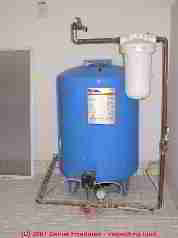
If a "captive air" bladder-type water pressure tank has a ruptured bladder, depending on the full air charge or pressure, air may be forced out of the pressure tank and through piping and fixtures as above. Every bit with our first case, the air menses will be temporary.
Merely in this case the water pressure tank volition go waterlogged and the water pump is likely to be short-cycling earlier long
Run into WATER PUMP SHORT CYCLING).
A new water force per unit area tank or a bladder replacement will be needed. We hash out captive-air water tank bladders, their maintenance, bursting, and repair,
at WATER TANK BLADDERS & CAPTIVE AIR.
How a Bad Bank check Valve can Crusade Air Discharge at Fitting
A lacking or improperly installed check valve on a private pump and well organisation can also cause air discharge from the edifice'due south faucets. A faulty bank check valve that allows water to drain back into the well causes negative pressure or "suction" that can draw air and contaminants into the well pipage or into the well itself.
See details at Cheque VALVES, WATER SUPPLY.
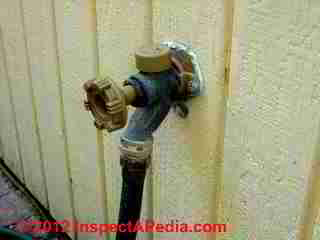
Sentinel out: when diagnosing the cause of air discharge from building faucets, it's easy to misdiagnose the cause: from within the building the symptoms of a bad bank check valve (loss of prime number, possibly air discharge at fitting) can look a lot like a hole in the well piping, especially if the pigsty is in the pipe rising within the well itself (also causing loss of prime, air at faucets) - every bit nosotros discuss further just below.
A leaky sill cock cheque valve or backflow preventer (shown higher up) might also introduce air into building h2o pipes.
How Leaks in the Well Pipe Can Cause Air Discharge at Plumbing equipment
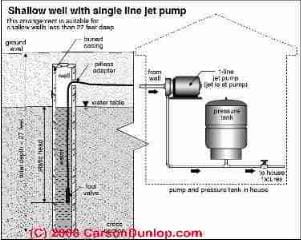 Experts note that when the pump shuts off, if in that location is a hole or leak in the well pipe, the hole allows air into the well line; when the pump is running, water sprays out of the same hole, peradventure calculation to rust and debris in the well and the pumping of silty or dirty water into the building.
Experts note that when the pump shuts off, if in that location is a hole or leak in the well pipe, the hole allows air into the well line; when the pump is running, water sprays out of the same hole, peradventure calculation to rust and debris in the well and the pumping of silty or dirty water into the building.
While h2o piping is under force per unit area and water leaks out rather than air leaking in, if we have the combination of lost water pressure (for case during an electrical power loss or a well system being shut downwardly), and leaks in the well pipe, as water drains backwards into the well air may be drawn into the h2o pipe through piping leaks.
If the pipe leak is inside the well casing where plenty of air is available, and if the well pipe includes a defective (leaky) pes valve or cheque valve in the well, this bike could repeat and building occupants may see recurrent air belch from plumbing fixtures.
Run into WELL PIPING FOOT VALVES.
You may be able to diagnose this problem by turning off all water supply in the edifice and watching what happens to the water force per unit area gauge at the pressure tank.
If the water pressure falls slowly fifty-fifty when you are certain no water is running in the building, there is probably either a bad human foot valve or check valve in the well, or a leak in the water pipage between the well and the building. But picket out - water pressure gauges tin be inaccurate or slow to respond to changes in water force per unit area -
run into WATER PRESSURE GAUGE ACCURACY.
Air Leaks in well pipage, connections, check valves, fittings, or even the pump itself: leaks anywhere betwixt the well and the building can introduce air into the well piping and h2o supply system.
Air can leak into well pipage anywhere between the acme of water column in the well at the end of a pump cycle (that'due south somewhere beneath the acme of the static head of the h2o cavalcade), and the water pressure level tank: that includes both vertical and horizontal sections of well piping.
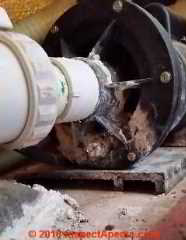
Leaks in well piping or at valves or check valves, at the pitless adapter o-rings, or even at the pump itself (shown above). A pinhole leak can exist hard to track downwards, especially on the suction side of pumping systems where you won't see water leaks. Low h2o in a well that allows a pump to draw air also places a lot of air into the water supply organization.
If there is a severe well piping leak or a water pipe leak or running plumbing fixture in a building the well pump may brainstorm to run continuously
- meet H2o PUMP WONT End RUNNING.
Picket out: a hole or leak in a well pipe or a defective or improperly installed bank check valves on a private pump and well system can also cause air belch from the building's faucets.
A faulty check valve that allows h2o to drain back into the well causes negative pressure or "suction" that can describe air and contaminants into the well piping or into the well itself. See details
at Bank check VALVES, Water SUPPLY.
Experts note that when the pump shuts off, if at that place is a hole or leak in the well piping, the hole allows air into the well line; when the pump is running, water sprays out of the aforementioned pigsty, possibly adding to rust and debris in the well and the pumping of silty or muddied water into the building.
Encounter WATER SUPPLY / DRAIN PIPE LEAK TYPES for details on diagnosing types of water piping leaks.
Also run across PUMP Prime, REPEATED LOSS of for additional diagnostic assist with well pipe and human foot valve leaks.
How Loss of H2o in the Well Can Cause Air Discharge at Plumbing Fixtures
A falling water tabular array or decline in well recovery rate may cause the well pump to send a mixture of h2o and air into the well piping and building.
If this status is occurring you might notice that the air discharge at plumbing fixtures is intermittent: when no water has been run overnight and the well has recovered, once existing in-pipage air has blown out, the water flow may appear normal, without air discharge.
Only as well water level drops and the well is irksome in recovering, the air discharge problem will return. In sum, these well or well and pump conditions can cause air to be delivered by the well pump into the building's water supply pipage:
If your well yield (how much water y'all can become out of the well) is inadequate water level in the well may drib low enough for air to enter a submersible (in well) pump or into the foot valve.
The combination of a too-small-scale WELL DYNAMIC Caput & STATIC HEAD DEFINITION (h2o reserve) in the well and a poor flow rate brand this problem more probable. A well that has performed adequately in the past may no longer accept an adequate yield for a multifariousness of reasons: drought, a drib in the water table, drilling of new wells nearby, or yield loss due to mineral clogging of rock fissures that feed h2o to the well.
If the well pump is likewise large incapacity (pumping charge per unit) for the well's prophylactic yield so air may be drawn into the well pump and water piping when the pump drops water level in the well too low.
The safe yield for a well may modify if the water table drops. And so, if the well pump output rate exceeds the safety yield for the well, air may exist injected into the building water piping and the well pump may exist damaged.
See inadequate WELL FLOW Rate for more information.
Meet WELL YIELD DEFINITION where nosotros define safe well yield.
See Water Pressure STOPS, RETURNS - for symptoms of loss of h2o in the well and slow well recovery rates.
See Water Pressure LOSS DIAGNOSIS & REPAIR for our consummate article series on diagnosing loss of h2o or h2o pressure level at a building.
Defective or Damaged Well Pump Can Cause Air Discharge at Fitting
It is possible that a failing well pump may innovate air into the water supply piping organisation due to cavitation (a vacuum forming inside the well pump mechanism), causing dissolved gases to come out of solution.
Cavitation and air leaks into a water pump may be more likely with an to a higher place-ground jet pump and less likely with a submersible in-well pump that would be expected to be ever submerged in h2o.
See H2o PUMP LIFE EXPECTANCY.
If a new well pump has been installed and is over-sized, the level of water in the well may exist drawn downwards too rapidly when the pump is running, resulting in air entering the pump and being delivered to the building. This condition can likewise occur in times of drought or if your well is running dry out.
Defective Air Volume Command Can Crusade Air Belch at Fitting
An air volume command device may be installed on some bladderless water tanks to effort to keep the proper air accuse in the water tank. If the air volume control is leaky or not working properly it may be overcharging the h2o tank with air.
If this is the case the air discharge from plumbing fixtures volition be chronic.
SeeWATER TANK AIR VOLUME CONTROLS.
Gases in the Well and Water Supply Can Cause Air Belch at Plumbing Fixtures
In some areas gases, including potentially unsafe explosive methane gas, may leak into the water supply and may exist delivered into the building water pipe from a well. Other gases often found in well water include radon, CO2 in some locations, and dissolved sulphur (that rotten egg odor).
Watch out: methyl hydride gas in well water is a pollutant and may exist explosive. According to experts such as the New Hampshire Department of Ecology Services,
Methane at high concentration is explosive and thus at that place is a fire take chances if large amount of water with methane are used near an open up flame in a airtight space.
The presence of marsh gas gas in water tin can exist simplistically detected past agitating a small book of water in a plastic container in an outdoor location and attempting to ignite the gas released. Have a neighbor present when you try this testing.
If you have such a well you lot should contact your local department of environmental services and your building section.
Lowering the settings of the pump's starting time/cease switch and/or providing an air release vent on the water storage tank at the high bespeak of the stored water might permit this "off gassing" to occur at a point other than your faucet. Since this is a natural condition, and no damage is acquired, there is no need to take any particular action.
Dissolved gases may also be present in water simply would not unremarkably announced as bubbling or air blasts at a faucet. These include radon, carbon dioxide, hydrogen sulfide (rotten egg scent), or other gases from dissolved organic matter or chemicals.
But in some deep wells water at the well bottom, at higher pressure, may hold dissolved gases that convert to bubble class when water pressure is reduced to ambience air pressure at building faucets.
Changes in water temperature likewise touch on the amount of gases that remain dissolved in h2o - warming water drives gases out of solution.
Run into H2o POLLUTANT SOURCES
Test to Identify Marsh gas Gas in the Water Supply
Other common gases found in water likewise methane include CO2 and sulphur or dissolved sulphur.
Keech and Gaber describe how to collect a test sample for marsh gas and as well describe options for removing gases from h2o.
- Keech, Donald G., and Michael South. Gaber. "Marsh gas in water wells." Water Well Journal 36, no. 2 (1982): 33-36. original source retrieved from drinknwaterplus.com/documents/Methane%20in%20Water%20Wells.pdf
Bad Snifter Valve or Drain-Back Valve Tin Crusade Air Discharge at Faucets
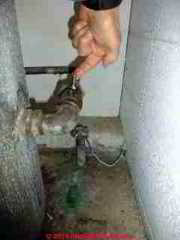
Snifter valves and drain-back systems used on submersible pump and well systems that employ a bladderless water pressure tank (or whose bladderless water tank was replaced with an internal bladder h2o pressure tank) can button excess air into the h2o pressure level tank.
Snifter valves & bleed-dorsum valves along with air volume control devices (AVCs) grade a 3-part air volume command system designed to
- allow water to bleed out of well piping and dorsum into the well at the end of a pump-on cycle and to
- maintaining the air charge in a well water pressure tank, thus also
- maintaining h2o force per unit area in the building between pump-on cycles
This system is used on deep wells and lake water supply systems for which the pressure level tank does not use an internal bladder. The required air accuse in the pressure tank is kept at the proper level by cartoon some air into the well piping organization at the end of each pump-on cycle.
The pump stops, h2o drains back down the well pipe into the well, air is drawn into the system at an higher up-ground air admittance valve, often by what looks like a tire valve or Schrader valve located on well pipage shut to the pressure level tank.
In the photograph I'grand pointing to the air admittance valve part of a snifter valve sysem on a bladderless water pressure level tank in a home in 2 Harbors Minnesota.
The snifter valve (or any other air book control device on a water pressure tank) can fail in either of two modes:
- It allows besides much air into the system: air will be discharged at the faucets the next time water is used. That problem may have led you to this page.
- Information technology allows too little air into the system: the h2o pressure tank will become h2o-logged (lose its air charge) and the well pump volition brainstorm short-cycling.
Run across WATER PUMP Short CYCLING - habitation
Watch out: If a bladderless h2o tank that used a snifter valve organization is replaced with a new internal-bladder tank you may demand to have a plumber pull the well piping to remove the (at present no longer used) drain and vent found within the well.
In the well an air-introducing cheque valve is installed in a higher place the acme of the static head of the water column to add together air to the bladderless water tank at each pump bike.
Even if the bladderless h2o pressure level tank was replaced with a new bladderless tank, if the snifter valve system was left in place but the excess air vent was non installed on the new tank (or is not working) you'll want to provide or repair these components.
Water Softener Check Valve Tin can Cause Air Belch at Plumbing fixtures
 Question: why exercise nosotros get air at our faucets later the water softener has gone through a regeneration cycle
Question: why exercise nosotros get air at our faucets later the water softener has gone through a regeneration cycle
2017/02/21 Quiggley said:
I have a Kenmore 625.393060 h2o softener and have the same problem of there being air in the h2o lines after a regeneration.
Typically, my outset use of water after a regeneration is with a toilet flush in the morning. There is always a noticeable release of air in the water line equally the toilet tank refills. What caused this?
Paradigm: a replacement water softener brine tube air check valve produced by Bit and widely sold at plumbing suppliers as a repair or replacement check valve for many water softener alkali tanks.
This question was posted originally
at WATER SOFTENER CLEANING & SANITIZING
Reply: wait for a clogged check valve on the brine selection-up tube or a leak in the brine tube betwixt softener and brine tank
2 common causes of air discharge at fitting that is traced to the water softener are
- a pinhole leak in the alkali tube between the softener and the brine tank
- a chock-full air check valve on the bottom of the brine pick-up tube in the brine tank
A leak in the brine tank tubing tin can be the problem. As alkali is returned to the softener during a regen cycle it may be accompanied by air that subsequently shows upward at building plumbing fixtures.
You should also pull out, inspect, and make clean the brine pick-up tube in the brine tank. An air cheque valve located (usually) on the bottom of the brine pick-up tub is intended to prevent air from existence drawn into the water softener from the brine tank.
At the end of the regen cycle the level of salty water in the brine tank falls depression enough that a brawl blazon cheque valve on the bottom of the brine selection-upward tube drops to prevent air from beingness drawn out of the brine tank and into the softener.
Pull out the brine pickup tube and place the air check valve on its end into a jar of vinegar for a few hours or longer to dissolve mineral deposits including common salt that may be causing information technology to jam. Some suppliers suggest using bleach - that makes trivial sense to me. Rinse the valve in fresh water and restore information technology into the brine tank.
If you accept whatever doubt about the valve or if you tin't convince yourself information technology's operating freely, merely replace it. A widely-sold air check valve for brine tanks is the Fleck J-Tube iii/8 " 10 34 " Long. This check valve tin be trimmed, if needed, to fit your common salt tank.
Come across WATER SOFTENER BRINE TANK AIR CHECK VALVE for details virtually this part.
At our FAQs for water softeners
at DIAGNOSE Water SOFTENER PROBLEMS nosotros too discuss air in the water system after a water softener regen cycle.
A less obvious cause of air belch at fixtures may correlat with resin loss from the water softener - that's a problem in the softener itself, discussed in detail
at H2o SOFTENER RESIN LOSS - symptoms of resin loss from a water softener and how the problem may be repaired
Water Treatment Equipment Can Cause Air Discharge at Plumbing equipment
- Air Treatment of Water to Remove Impurities or Odors: Deliberate introduction of air into the water system is sometimes used to treat other water impurities such as sulphur (rotten egg odor) or fe. Some air-introduction contaminant oxidizing systems use a venturi to add air to water passing through the system in society to oxidize the dissolved iron into a filterable sediment.
H2o treatment equipment can also inject air into a building h2o supply. Water handling to remove odors or gases from the water supply may utilise venturi air injectors intended to remove iron, manganese, or odors. Properly installed these devices should non ship air out of faucets. Just the post-obit weather can cause air injector treatments to place excess air in the building water supply pipe:
- A change in the water pump output rate may crusade a mis-match between the air injection rate at the injection nozzle or venturi and the total h2o quantity beingness delivered to the building
- A modify in water pipage that fails to properly pitch water supply pipe to an excess air relief valve
- A failure of the excess air relief valve to keep to release air - the valve may need cleaning or replacement
- An improper aligning of the air-to-h2o ratio at the air injection nozzle or venturi. Your h2o handling company technician can reduce the level of air injection to the minimum needed to remove the objectionable odor, atomic number 26, or manganese.
Other Sources of Air in Water Pipage - Work on Municipal Water Mains or Private Well Piping
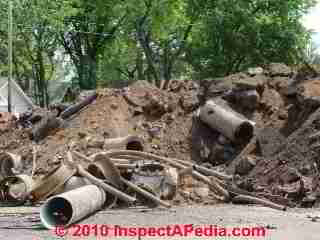 We list the well-nigh-common sources of air in h2o supply systems starting
We list the well-nigh-common sources of air in h2o supply systems starting
at AIR DISCHARGE at FAUCETS, FIXTURES
In that location may exist other causes of air discharge from building h2o supply piping, including the ones we list below.
- Aerator devices at faucets: Faucet aerators can produce fine white bubbling in the water coming from a faucet simply due to the faucet aerator designed to forbid splashing.
You tin can examination this source by temporarily removing the aerator. With the aerator removed, fill up a glass or clear pitcher with cold water and separately with hot water to cheque for remaining air bubbles.
- Temporary air introduction into municipal water supply pipage when work is being performed on the water system. Commonly such conditions are temporary. Enquire your h2o company if at that place has been recent work on the h2o mains in your expanse.
Air Eliminators for Potable Water Supply Systems
This topic has moved to a separate commodity. Please come across AIR ELIMINATORS for Beverage H2o SUPPLIES
Reader Q&A - also run into the FAQs series linked-to below
Not sure what'due south happening: cheque to see if yoru well pump is cycling on and off, trying to recover later having run the well out of h2o.
Turn OFF the h2o pump for a few hours to allow the well recover, then plow it back on.
And I should've added that the noises are while the h2o is NOT running
Deplorable, I meant increase in pitch from depression to high
My son left the kitchen faucet running for a couple hours. Now I'm hearing occasional "thunks" in the pipes and sometimes vibrations that concluding several seconds and that increment in pitch from low to pitch.
Anon,
I can't give an accented respond from the express data in your question. But in full general air bubbles in water or not harmful.
Our neighborhood had a main water pipe break and now when I fill my Brita pitcher with water it bubbles upwards all around it . I am concerned to drink our water
Linda
This sounds very expensive, and may exist a example of the OPM problem (Other People's Coin discussed at https://inspectapedia.com/home_inspection/Other_Peoples_Money.php
I would want a clear diagnosis of the trouble before throwing thousands of dollars at this. For example, you might become air discharge at fixtures just because an air comprisal valve or snifter valve (a small fitting) needs replacement.
Call someone else.
Have a blast of air beginning thing in morning had a plummer said it could be i of 3 things,1200 to supervene upon tank and fittings ,1700 to replace tank fittings bank check valve , 3400 to replaceall the above plus tank,he said it had a modest pool.well, tank,pump 8yrs ago,I'g not dumb tank cost 159,it was 90 degrees humidity was 77%,it's under the house
,sent him down the road with a 59 dollar fee lx dollars he didn't take alter(Angies list). I checked for leaks,pump doesn't run all the fourth dimension ,tank is is 32,pump comes on 35 ,goes to 50-55
We replaced our submersible well pump in April... No bug with air in water lines before and after replacing the pump.
Simply a few weeks later I proactively replaced the force per unit area tank and installed a 20" PurePro Sediment Filter. Now nosotros are getting significant air discharge everyday in our faucets. I replaced the hose spigot thinking the check valve might accept failed in that, but that was not the problem. Nosotros don't get the air discharge when running hot water, just cold h2o. Any ideas?
When nosotros plow on faucets a blitz of air makes a loud noise then water surges off and on
Bobby,
In addition to checking out the diagnosis of un-wanted air in the h2o system - (the article above on this page) - you might want to review the diagnostics at
WATER HAMMER NOISE DIAGNOSE & CURE
Let me know what you recollect and we'll take information technology from at that place.
When we turn on water in house it makes a popular and a air audio then it does it three or 4 times while it is running. It seems to exist doing it more and more
Okay cheers so much I will have my son try that.
I hold that a hissing sound suggests an air (or water) leak. When the pump is running, if at that place is an air leak INTO the pump system or housing you might encounter hissing simply won't see bubbles - air is moving in, not out of the assembly. I'd attempt tightening what you can observe to tighten, or re-making connections that apply pipe dope or teflon tape and that are near the pump.
Aloha,I have checked all of the waterline for the house and can't detect a h2o leak :( last year we had a problem with abiding running and found that the inlet coupling was clogged got it cleaned upwards now there is a constant hissing audio which sounds like it's in the inlet side of the pump my son put soapy h2o on it and couldn't find any air leaks would that show something similar that?
With apologies that I tin only brand a wild estimate with so little information, information technology sounds to me as if there is a leak in the piping for your system. That could be causing water to bleed back at the end of a pump-on cycle and thus to cause a pump to bicycle frequently.
We have an above ground catchment organisation,recently the pump has been going off and on about every minute we heard a hissing noise on the tank side of the pump.it sounds as though it's coming from the pipe but not really sure information technology is louder in that direction.the pressure gauge goes up to twoscore or so when the pump kicks on but drops way downward below 30 when information technology kicks off
About on this page beingness list probable causes of the air discharge problem that yous're describing.
Please take a look through those and and then encounter if y'all tin find a plumber I will admit that you have a problem and so do something about it
Nosotros take so much air in our pipes we are experiencing piddling to know h2o menstruum. If we get h2o menstruation, is irksome and sluggish. The volume is so bad nosotros struggle to shower, etc. We don't even take enough to wash dishes sometimes or it takes forever.
The water "oscillates" in the line. We get our water from the City. We put in a new hot water tank and if nosotros open up the hot water, we merely get 50% of the hot water that nosotros used to get - and that's on a expert twenty-four hour period.
Nosotros get plumbers in who say "they cannot see a problem" and then they don't set up anything and nosotros live in misery. Please help.
The article above on this page lists the most likely sources of air belch at the faucet including the case that you described. I don't recollect that the temperature setting is the problem. We're likely there's a leak
Take lived in this house almost 30 yrs. Never air in drink water. 186' deep well.
Had new boiler installed with banality heated potable water.
Installer has adjusted temperature between potable h2o and hydronic heating system. Air comes out of all fixtures with a vengeance specially in the morning after non existence used all night.
Cheers for whatever communication.
John
Randy
Only to be clear, if when y'all open a faucet the pressure in the pressure tank doesn't drop, then the tank is non working - possibly it's outlet is blocked or a valve is closed somewhere.
Leaks can be slow: I'd want to meet what the organisation water force per unit area is when the pump turns on. If it's non below the CUT_IN then something'southward rotten in the state of WaterDenmark - perhaps a droppings-clogged pressure control or debris clogged pressure level gauge or both.
Thank yous for your response, I have not quite accost the situation yet.
I want to say that my pressure tank holds a strong sixty pounds of pressure continuously. And I observed it for twenty minutes with no loss .
So I'm ruling out a leak at least below the check valve. But cheers and y'all are correct I am becoming more of an expert than I ever wanted to be.
I volition keep you posted
Randy
Thanks for the interesting question and groovy details.
I doubtable you're more-expert than I at this point.
I've had abrasive air leaks on plastic well pipe and have approached it first adding a hose clamp and tightening every single fitting that I could admission.
Seeing even a reduction if not complete end in the air entry tells me I've got the right problem ID only notwithstanding accept a bad connector.
Your suspicion of the bank check valve makes sense but keep in heed it could be the pipe connections not the check valve itself.
The down-side of moving the check valve further from the well is that you lose the advantage information technology'south giving you lot in the first place - that'south why you had muiltiple check valves with the original pump - to reduce the backpressure load and trend for water to flow dorsum into the well, right?
But dropping the check valve to be under water is very clever in my OPINION since then fifty-fifty if there'southward a small leak, when the pump stops, as long equally the check valve is still under water, you won't suck air into the piping.
(Remember that as your new superpump runs the static head or level of water in the casing will drop - just how far depends on the period charge per unit (inflow of water) into the well. So put the check valve far enough down that you retrieve information technology volition never be in air.
Please keep me posted on how that works.
Thanks for any and all responses. Beginning of all I'd like to say I'yard a exercise-it-yourself plumber. This is my second fourth dimension replacing my well
. The kickoff time 240 ft with a 1 horsepower deep well pump . And three check valves. i @50 foot above pump ,the other onehundred pes above check that check valve and then the tertiary another lxxx' +/- to a higher place that valve.
Which that pump lasted me five years, I had to pull it three times to repair leaks at the check valves.
The check valves that was 50 pes above the pump literally had a hole blown into it, on the brass coupling. Tells me too much power?
At present my newest well, I put a ii horsepower Schrader pump .I purchased a 300 human foot length of pipe, black PVC .
I have a pump 227' ft down .with one pipe length. And just one check valve.
Aprox 15" below the top casing. Having read all kinds of opinions and a like-minded by and large with and older plumbers.
I have extremely good pressure level, nonetheless I'm getting air in the system.
I believe the culprit is the check valve that is just below my well cap.
And it's the merely check valve. Too the one that is factory installed with pump.
I'm suspecting that'south where my air is coming from. Reading many opinions and agreeing with near every i of them ,for 1 reason or the other.
My question is do I motility the check valve closer to my property tank.
Or drop it down approximately 75 to 100-human foot and then it volition exist under water. My well depth is 248 ft , my well point is 227' deep was approximately 177 ft of water on top. And I used the cotton rope with weight method. Thanks so much for any advice.......
Image lost -delight re-post.
Yep, under some unusual atmospheric condition (such as loss of edifice h2o pressure) if the outside faucet has been left open.
can a outside water faucet let air into the whole organisation and make sink and toilet spitt air
...
Go along reading at AIR ELIMINATORS for Drinkable H2o SUPPLIES or select a topic from the closely-related articles below, or run across the complete Commodity INDEX.
Or see AIR Belch at FIXTURES FAQs - questions & answers virtually air sputtering at faucets or other plumbing equipment and at their continuation at AIR Belch at FIXTURES FAQs-2
Or encounter these
Recommended Articles
- AIR DISCHARGE at FAUCETS, FIXTURES
- AIR ELIMINATORS for POTABLE Water SUPPLIES
- AIR INLET VALVES
- AIR Volume CONTROLS, WATER TANK
- SNIFTER & Bleed Dorsum VALVES
- Water PUMP SHORT CYCLING
Suggested commendation for this spider web page
AIR DISCHARGE at FAUCETS, FIXTURES at AuditApedia.com - online encyclopedia of building & ecology inspection, testing, diagnosis, repair, & problem prevention advice.
Or meet this
Alphabetize to RELATED Manufactures: Commodity INDEX to H2o SUPPLY, PUMPS TANKS WELLS
Or use the SEARCH BOX constitute below to Ask a Question or Search InspectApedia
...
Ask a Question or Search InspectApedia
Try the search box only below, or if you prefer, mail a question or annotate in the Comments box below and we volition respond promptly.
Search the InspectApedia website
Annotation: appearance of your Comment below may be delayed: if your annotate contains an image, web link, or text that looks to the software every bit if it might be a web link, your posting will appear subsequently information technology has been approved by a moderator. Apologies for the delay.
Technical Reviewers & References
Click to Show or Hibernate Citations & References
Publisher InspectApedia.com - Daniel Friedman
Source: https://inspectapedia.com/water/Air_Discharge_at_Faucet.php
0 Response to "what causes air to get into water lines?"
Post a Comment